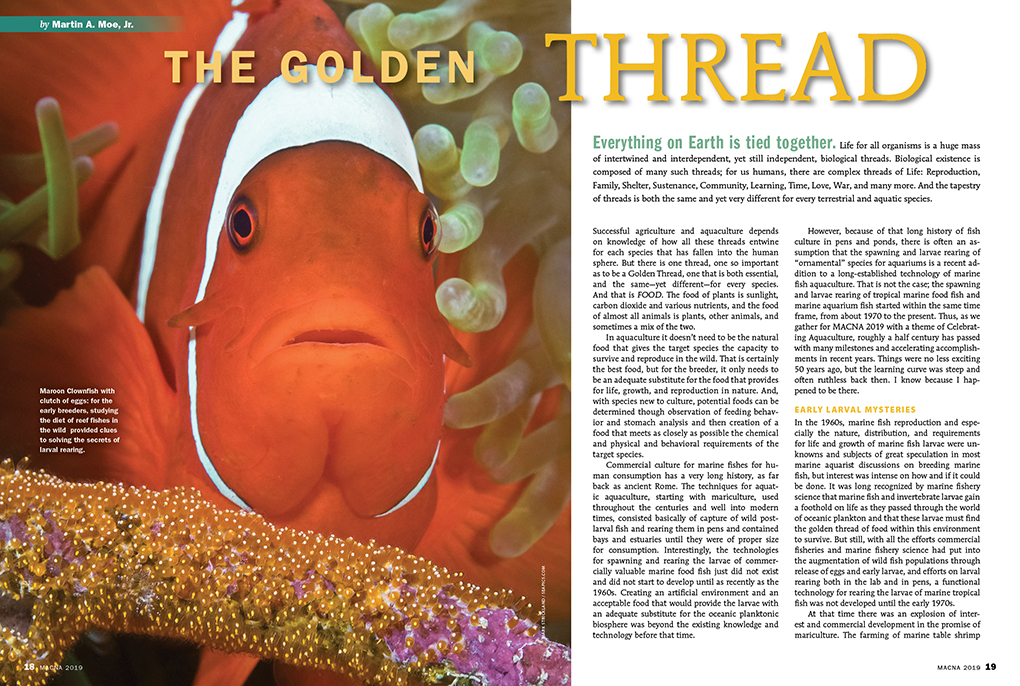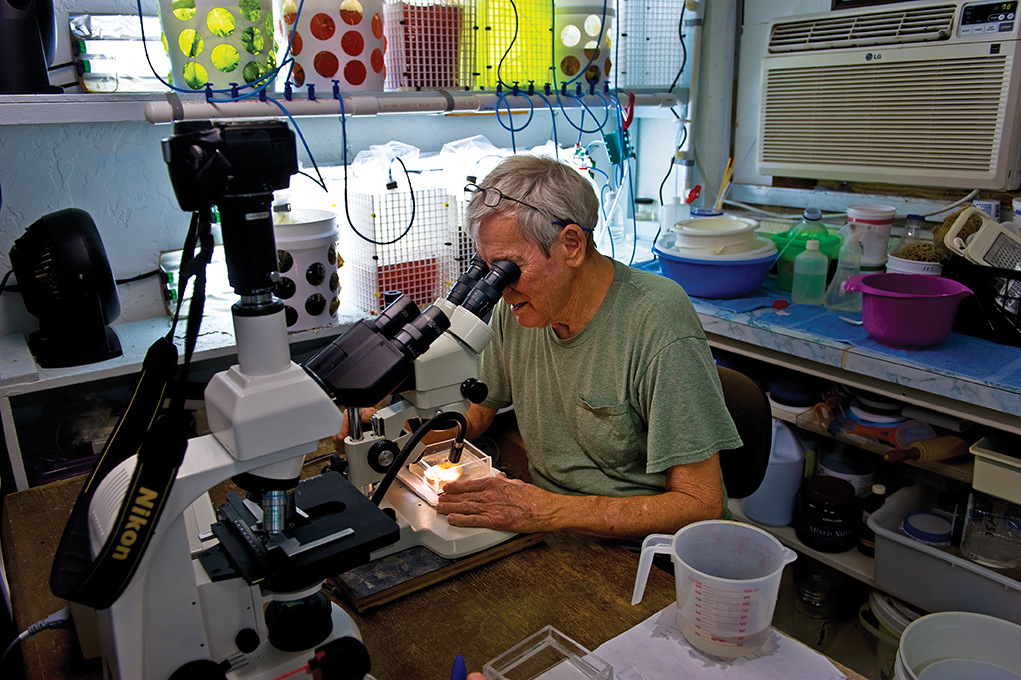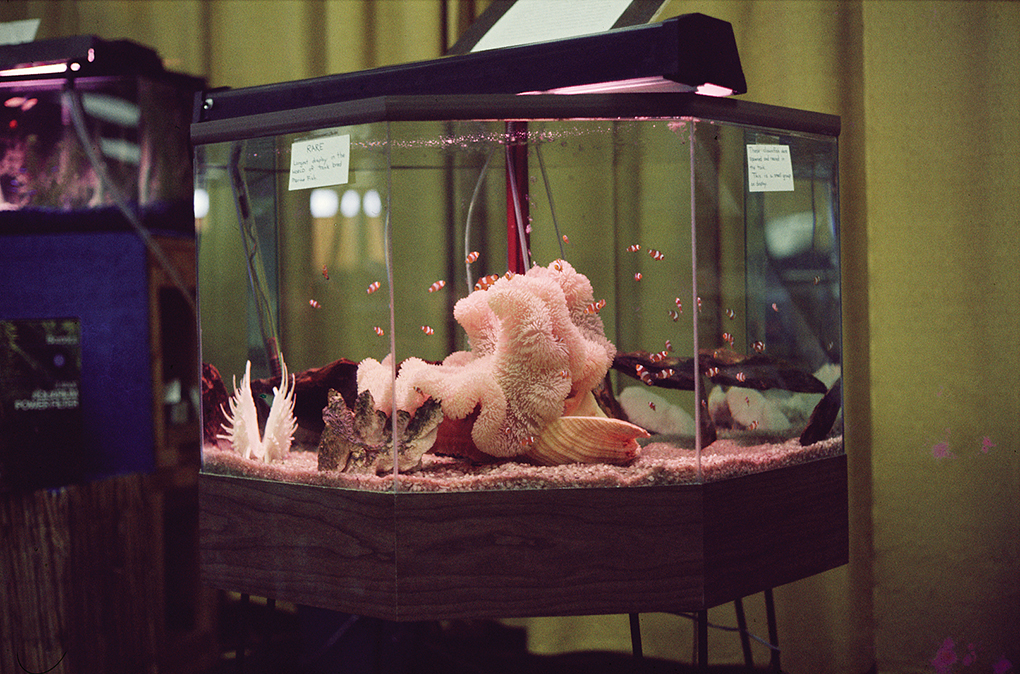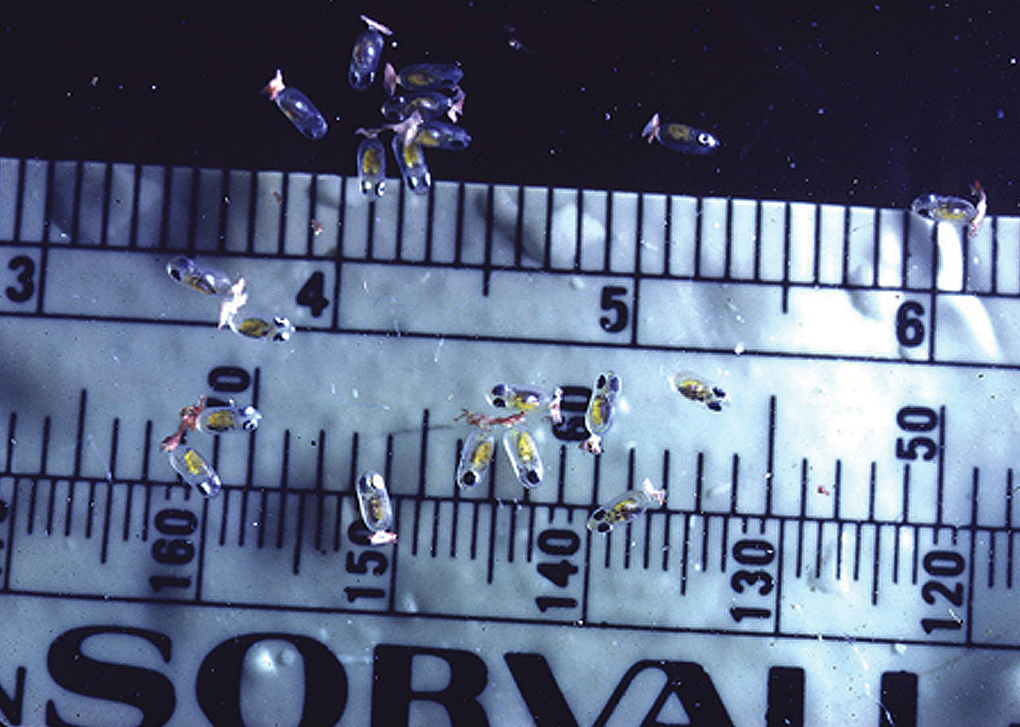By Martin A. Moe, Jr.
Everything on Earth is tied together. Life for all organisms is a huge mass of intertwined and interdependent, yet still independent, biological threads. Biological existence is composed of many such threads; for us humans, there are complex threads of Life: Reproduction, Family, Shelter, Sustenance, Community, Learning, Time, Love, War, and many more. And the tapestry of threads is both the same and yet very different for every terrestrial and aquatic species.
Successful agriculture and aquaculture depends on knowledge of how all these threads entwine for each species that has fallen into the human sphere. But there is one thread, one so important as to be a Golden Thread, one that is both essential, and the same—yet different—for every species. And that is FOOD. The food of plants is sunlight, carbon dioxide and various nutrients, and the food of almost all animals is plants, other animals, and sometimes a mix of the two.
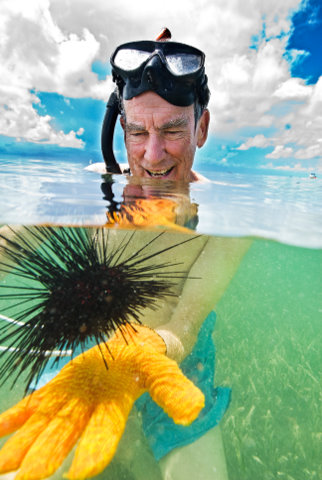
The author with Diadema antillarum broodstock used in his captive-culture research, Islamorada, Florida. Image: Matt Wittenrich.
In aquaculture it doesn’t need to be the natural food that gives the target species the capacity to survive and reproduce in the wild. That is certainly the best food, but for the breeder, it only needs to be an adequate substitute for the food that provides for life, growth, and reproduction in nature. And, with species new to culture, potential foods can be determined though observation of feeding behavior and stomach analysis and then creation of a food that meets as closely as possible the chemical and physical and behavioral requirements of the target species.
Commercial culture for marine fishes for human consumption has a very long history, as far back as ancient Rome. The techniques for aquatic aquaculture, starting with mariculture, used throughout the centuries and well into modern times, consisted basically of capture of wild post-larval fish and rearing them in pens and contained bays and estuaries until they were of proper size for consumption. Interestingly, the technologies for spawning and rearing the larvae of commercially valuable marine food fish just did not exist and did not start to develop until as recently as the 1960s. Creating an artificial environment and an acceptable food that would provide the larvae with an adequate substitute for the oceanic planktonic biosphere was beyond the existing knowledge and technology before that time.
However, because of that long history of fish culture in pens and ponds, there is often an assumption that the spawning and larvae rearing of “ornamental” species for aquariums is a recent addition to a long-established technology of marine fish aquaculture. That is not the case; the spawning and larvae rearing of tropical marine food fish and marine aquarium fish started within the same time frame, from about 1970 to the present. Thus, as we gather for MACNA 2019 with a theme of Celebrating Aquaculture, roughly a half century has passed with many milestones and accelerating accomplishments in recent years. Things were no less exciting 50 years ago, but the learning curve was steep and often ruthless back then. I know because I happened to be there.
Early Larval Mysteries
In the 1960s, marine fish reproduction and especially the nature, distribution, and requirements for life and growth of marine fish larvae were unknowns and subjects of great speculation in most marine aquarist discussions on breeding marine fish, but interest was intense on how and if it could be done. It was long recognized by marine fishery science that marine fish and invertebrate larvae gain a foothold on life as they passed through the world of oceanic plankton and that these larvae must find the golden thread of food within this environment to survive. But still, with all the efforts commercial fisheries and marine fishery science had put into the augmentation of wild fish populations through release of eggs and early larvae, and efforts on larval rearing both in the lab and in pens, a functional technology for rearing the larvae of marine tropical fish was not developed until the early 1970s.
At that time there was an explosion of interest and commercial development in the promise of mariculture. The farming of marine table shrimp was off and running and there was a great deal of interest and effort in developing the technology for the commercial culture of other marine species, including Florida Pompano, Trachinotus carolinus. I was then the Senior Fisheries Biologist at the Florida Board of Conservation Marine Laboratory in St. Petersburg and had just completed a paper on pompano culture based on my oversight of a project that captured small Florida Pompano in the surf off St. Augustine and farmed them in large ponds located on land between Matanzas Inlet and the Atlantic Ocean. Pompano are an important and highly valued commercially fished species in Florida and were an obvious target for marine food fish aquaculture.
Plankton Breakthrough
In the spring of 1969, I was offered a job as director of research with a new company, Oceanography Mariculture Industries that had established quarters in a shopping center on the Florida east coast in West Palm Beach. I knew from my previous work that there were two ways to feed larval marine fish. The first was to collect and maintain wild marine plankton, and that larval marine fish could survive and pass through metamorphosis into juveniles on what they could find in this mix of marine plankton. But wild plankton was very iffy in its collection, maintenance, composition, and adequacy as a larval food. It could not be relied upon to rear large numbers of larvae. Then, during my work with pompano, a friend named Phil Heemstra told me that Dr. Ruben Lasker, a scientist at Scripps Institute of Oceanography, was working with a tiny marine microorganism, a rotifer, to study the life history of herring. We scrambled to set up a rearing system and quickly found that rotifers could be reared in vast numbers and were an acceptable first food for pompano larvae.
Things unfolded in many unexpected ways, and in 1972 I left the Florida Pompano project and returned to the University of South Florida to finish work on my Ph.D., but I now had a key to that seemingly impenetrable door to breeding marine tropical fish for the emerging saltwater aquarium trade. By that time, awareness that marine tropical fish larvae existed and developed in that strange world known as oceanic plankton was more and more becoming common knowledge; but what they were like, where they went, how long they were larvae before they became actual juvenile fish, and most important what they ate, were obstacles that caused many to have the opinion that marine tropical fish could never be bred. It was obvious that the key to rearing the larvae of marine fish, that essential thread of animal existence—food—was hidden in marine plankton. What did they eat? Obviously: very tiny organisms, and many thought that marine microalgae were the most likely early food. But I knew that properly sized plankton and/or cultured rotifers could provide the nutrition that the early larvae of marine fish required. That knowledge was like an itch that wouldn’t go away.
So while attending classes at USF, I worked out a basic food for the adult Common Clownfish, Amphiprion ocellaris, by finding stomach analysis in the literature and creating a food that could be frozen and properly sized for feeding adult clownfish. I also looked at how to handle and hatch the benthic eggs that they spawned, and then creating a larva-rearing environment that provided an adequate substitute for the food organisms and environment of an oceanic planktonic realm.
It worked, and soon in mid-1973, my wife Barb and I were selling the world’s first Tank Raised Clownfish! As unique as these fish happened to be, buyers were only willing to pay the princely sum of thirty-five cents each, or the equivalent of $2.02 in 2019 dollars. At the time this was the price importers were paying for wild-caught clownfish, and they would pay no more than that even though the mortality rate for wild-caught clownfish was huge and the mortality rate for tank-reared fish was extremely low. But this opened the door to tropical marine fish culture, if just a crack, and soon (actually it took a few years) there were a few enterprising companies in the business of breeding a number of species of marine tropical fish. Things appeared promising.
What I didn’t realize was that although the marine aquarium hobby was growing and becoming an important part of the aquarium world, it was not yet at the point where it could economically support the culture of marine tropical fish. (There would eventually be more than a few entrepreneurial skeletons and failed companies in this early aquaculture closet.)
We were still working with my small garage-based marine tropical fish hatchery when the subject of additional species came up. Would breeding other species of marine tropical fish be adaptable to the technology we had developed? And if so, what species would be the best to try next. The obvious choice was the Neon Goby (then Gobiosoma oceanops, now Elacatinus oceanops). This small, brilliantly blue and back, parasite picking, coral reef dweller was a popular marine tropical fish even in those early days; it could be easily kept and induced to spawn in small tanks, and had a history of breeding experimentation. But in 1973, when my experiments began, there was no record or reports of Neon Gobies being reared through the larval stage, at least not in the scientific literature or in marine aquarium circles. We were quickly successful at breeding hundreds of Neon Gobies with the same equipment and technology that was successful with clownfish.
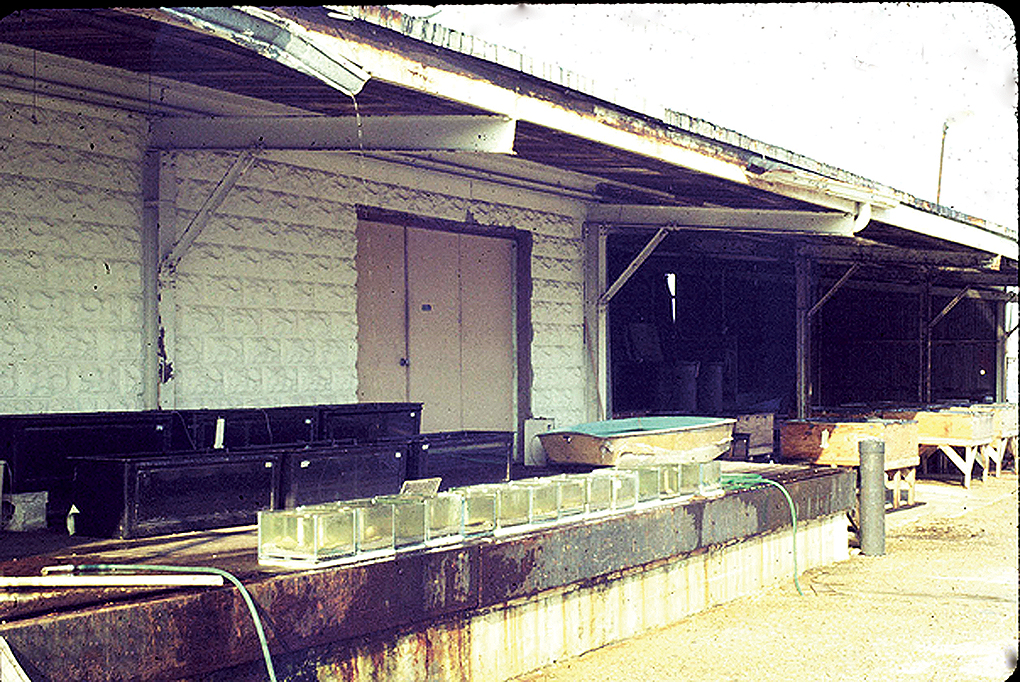
Aqualife Research’s home in an old ice house in St. Petersburg, Florida: the world’s first marine fish hatchery.
The First Commercial Hatchery
My wife and partner Barb and I knew that we could not continue with clownfish broodstock tanks in the living room, Neon Goby broodstock tanks in the laundry room, a larval rearing system on the right side of the garage, and a 4x8x2-foot growout tank on the left side of the garage. We had to start a company and find a place to build a hatchery. My Ph.D. program was getting mired down, and since my future seemed to be now defined by tropical marine fish culture, in mid-1973 I sort of bowed out of continuing my academic career and concentrated on a new venture, Aqualife Research, our fledgling marine tropical fish hatchery.
We found an old empty space, what used to be an old ice house in St. Petersburg on the shore of Bayboro Harbor and, on a shoestring, we built the world’s first commercial marine fish hatchery. The shoestring was evident, but we were soon commercially producing clownfishes: Ocellaris, Tomato, Pink Skunk, Orange Skunk, Clarkii Clownfish; and Neon Gobies. There were only two commercial, marine tropical fish hatcheries in that time period, Aqualife Research, and Neptune’s Nurseries, a sister company of the rich and powerful Aquarium Systems which had recently entered the field. Aquarium Systems was determined to begin production of marine tropical fish in the medium of Instant Ocean aquarium salts. They hired my old friend Frank Hoff and Tom Frakes to design and build the experimental phase of their entry into breeding marine fish about three blocks down the road from our location. This spawned an interesting competition between the two companies. We had history and we were friends, but we kept secrets, and we had great interest in what they were up to and what they had accomplished recently. We had different problems and approaches—natural seawater versus artificial seawater—but we were both successful in producing tank-reared clownfish.
Our company moved to the Florida Keys in 1975, because, well, that’s where the fish are, or unfortunately, were. Most experimental rearing work with marine tropical fish is conducted near where the fish occur in nature, tropical waters around the world. One of the reasons we moved to the Florida Keys was because that was where Atlantic angelfishes—Queen, Blue, Rock Beauty, Gray, and French—lived and reproduced. We worked with all of these species, spawning on demand and working on rearing the larvae. I expected great results with all these species; after all, almost every species I had worked with up to that time, about 30, could be reared through the larval stages with the technology we had developed.
By 1976, Aqualife was producing many clownfish and gobies and working on the production of other species such as Yellowhead Jawfish, Royal Gramma, Yellowtail Damselfish (Jewelfish), Blue Hamlet, as well as hogfish, Porkfish, and even Spiny Lobster, but by far the most effort was expended on angelfishes. The golden thread was food, and it was snarled in a bottleneck for us. Rotifers had proved very valuable as first foods for other larvae, but they did not work for all species. It turned out that only Gray and French Angelfish had eggs (1mm) of the size that showed promise of adapting to our rearing techniques. It also turned out, and it was an unpleasant surprise, that these larvae absolutely would not feed on rotifers. Dissection of larval stomachs produced nary a rotifer but often a copepod or copepod nauplii or two would show up in otherwise empty stomachs. So we went back to wild plankton, which within the variable parameters of collection, maintenance, and dealing with various contaminants, worked well, and we reared thousands, and even hybridized the two species. But it was obvious that there had to be a way to culture copepods. We tried, tried very hard, but given the resources we had back then, and the equipment and knowledge we did not have, it was not possible for us to develop an adequate method of culturing copepods for feeding small larvae.
Onward to Dottybacks & Diadema Urchins
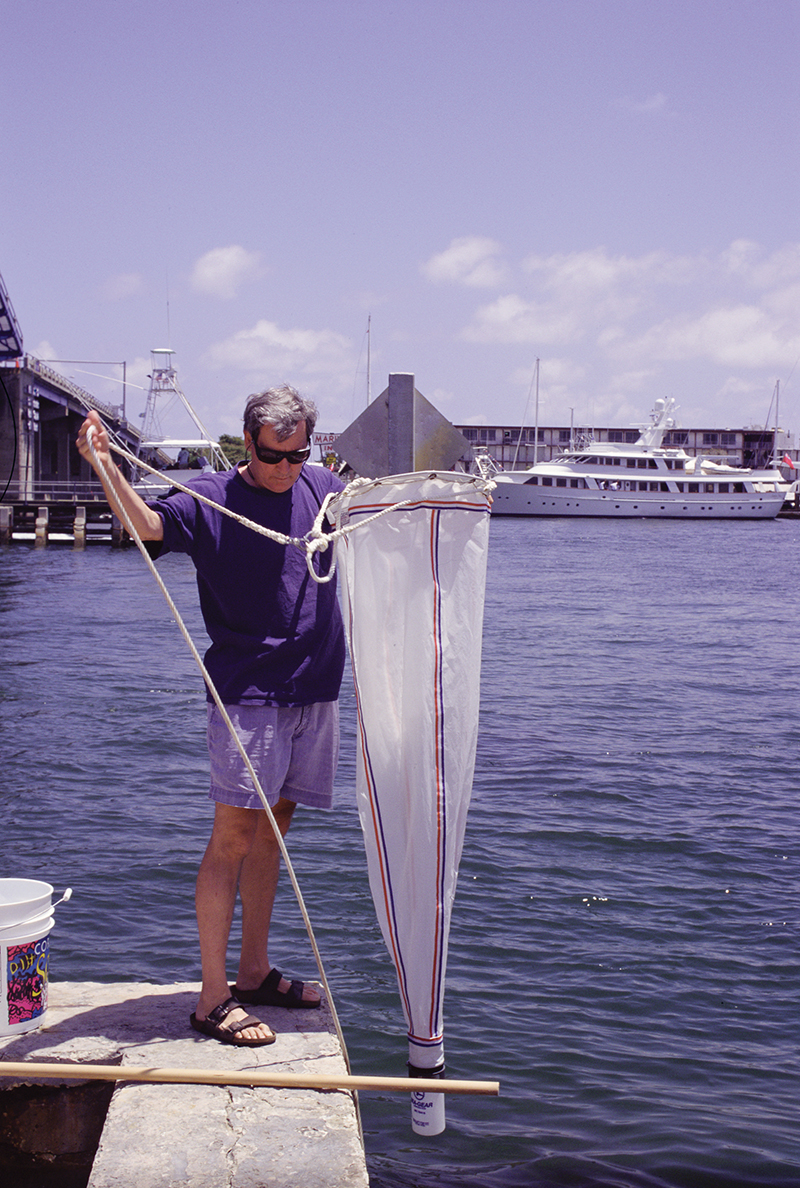
The author collecting plankton: much remains to be learned about micro-plankton for marine breeding and reef aquarium husbandry. Image: Matt Wittenrich.
The 1980s and 1990s saw tremendous changes in the marine aquarium hobby: great growth, changes in technology and equipment, development of live sand aquariums, live rock aquariums, marine reef aquariums, lighting from fluorescent to metal halide to LED, and even DNA sequencing becoming important in taxonomy of marine animals. My time was spent writing books and articles and later in developing a method for rearing the Orchid Dottyback in a small room in our house in Ft. Lauderdale. Then from 2000 to 2019 most of my time was spent in larger, but still home-based marine culture lab in our home in Islamorada (back in the Keys) working out the technology for spawning and rearing the keystone herbivore of the coral reefs, the Longspine Sea Urchin, Diadema antillarum.
So, taking a jump from the early 1970s to almost 2020, a leap of close to 50 years, we are finally at the point where copepod culture is becoming an important part of marine aquarium husbandry and breeding. And it seems like this happened relatively quickly once things began to come together.
Bacteria have long been a foundation to the understanding and operation of the biology and ecology of the captive marine systems know as marine aquariums. But there was something missing, or at least not recognized or not widely appreciated in the food webs of a marine aquarium. It was long known that the planktonic element of oceanic ecology was missing from small captive systems, but it appeared that there was nothing we could effectively do about this omission. That is changing.
Copepods and other marine bugs like amphipods are, or were, a missing essential biological element in the microcosm of a marine reef/fish aquarium. I believe that recognition and availability of this micro-planktonic element to the science of modern marine aquarium maintenance and marine fish culture will be helpful in coming years to greater success with the captive ecology of reef aquariums and essential to the culture of many marine species. This development could extend and enlarge the thread of vital foods that winds through the marine aquarium hobby and needs to be a very important element in the successful modeling the modern reef aquarium to the intimate world of Mother Ocean.
I think that in the future, we will have to distance the marine aquarium hobby from a dependence on the oceanic environment further than ever before. Not only will we have to rely much more on marine aquaculture to provide life for marine aquariums, we will have to use the knowledge and biological structure of captive marine environments to better understand and help correct the rapidly increasing physical and chemical decay of the natural marine environments of our Earth. The Golden Thread of human life on this planet may depend on it.
Acknowledgments
This is my personal story, but many others, too many to credit here, played key roles in getting us from the earliest days of clownfish breeding to today’s successful culture of tangs and magnificent marine angelfishes. There are so many individuals in so many university and government laboratories and so many private companies and people working from home and creating small businesses who have advanced the knowledge of breeding marine fish and invertebrates that listing them all and describing their accomplishments would fill a very thick volume. Many of these people will be attending MACNA 2019, and I hope to see many old friends here. Some are still making things happen now that in the not too distant past were considered impossible. They are all part of an unbroken thread in the tapestry of marine aquarium science, trade, and hobby.
The Author
Martin A. Moe, Jr. is a marine biologist, experimental aquaculturist, and author of numerous books, including The Marine Aquarium Handbook, Beginner to Breeder (Revised & Expanded Edition). Microcosm/TFH, 2009.
